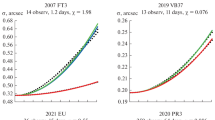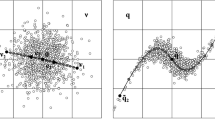Abstract
A collision of an asteroid with the Earth in the future is always considered as a probabilistic event because the asteroid orbit determined from observations with random errors inevitably contains an uncertainty in its parameters. To establish the probability of collision, the parametric uncertainty as a probabilistic distribution of virtual objects is mapped by the orbital model into the physical space for the period of the asteroid rendezvous with the Earth, and then the probabilistic mass penetrating into the planet body is estimated. The asteroid impact on the Earth is a very significant phenomenon because it can have fatal consequences for mankind. Therefore, probabilistic estimation of collision with potentially hazardous asteroids must be carried out very carefully with allowance for various subtle aspects. In this work, nonlinearity in inverse problems of asteroid dynamics under different observation conditions for various types of determined orbits is studied. The main problem we set ourselves is to examine to what extent nonlinearity can affect the accuracy of a probabilistic estimation when the parametric uncertainty is simulated using classical linear stochastic methods. To study the total, parameter-effect, and intrinsic nonlinearities, we introduce original indices with justified threshold values determined from the maximum tolerable biases of probabilistic estimates due to nonlinearity. The general analysis of nonlinearity is carried out for potentially hazardous asteroids observed in one appearance before June 2020. In particular, it is shown that main factors of strong nonlinearity are the short observed orbital arc (less than one degree) and the small observation period (less than ten days). Moreover, the situation is aggravated if the asteroid moves during the observation along the ecliptic and near it on an arc with small curvature. It is also established that, due to strong nonlinearity in problems of probabilistic estimation, nonlinear stochastic methods are required to simulate the orbital uncertainty for almost half of the potentially hazardous asteroids (44%).











Similar content being viewed by others
Notes
The intrinsic nonlinearity does not depend on the choice of the initial epoch.
REFERENCES
Avdyushev, V.A., Chislennoe modelirovanie orbit nebesnykh tel (Numerical Modeling of Orbits of Celestial Bodies), Tomsk: Izd. Dom Tomsk. Gos. Univ., 2015.
Avdyushev, V.A., Intrinsic nonlinearity and method of disturbed observations in inverse problems of celestial mechanics, Celest. Mech., 2017, vol. 129, no. 4, pp. 537–552.
Avdyushev, V.A., Nonlinear methods of statistic simulation of virtual parameter values for investigating uncertainties in orbits determined from observations, Celest. Mech., 2011, vol. 110, no. 4, pp. 369–388.
Bates, D.M. and Watts, D.G., Nonlinear Regression Analysis and Its Applications, John Wiley & Sons Inc., 1988.
Bates, D.M. and Watts, D.G., Relative curvature measures of nonlinearity, J. R. Stat. Soc., 1980, vol. 42, no. 1, pp. 1–25.
Beale, E.M.L., Confidence regions in non-linear estimation, J. R. Stat. Soc., 1960, vol. 22, no. 1, pp. 41–88.
Bordovitsyna, T.V., Avdyushev, V.A., and Chernitsov, A.M., New trends in numerical simulation of the motion of solar system small bodies, Celest. Mech., 2001, vol. 80, nos. 3–4, pp. 227–247.
Bowell, E., Virtanen, J., Muinonen, K., and Boattini, A., Asteroid orbit computation, in Asteroids III, Bottke, W.F., Jr., Eds., Tucson: Univ. Arizona Press, 2002, pp. 27–43.
Chernitsov, A.M., Analysis of some simplified schemes for determining estimates of the parameters of the motion of celestial bodies, Astron. Geod., 1975, no. 5, pp. 6–19.
Chernitsov, A.M., Baturin, A.P., and Tamarov, V.A., An analysis of some methods for the determination of the probabilistic evolution of motion of the solar system’s small bodies, Sol. Syst. Res., 1998, vol. 32, no. 5, pp. 405–412.
Chernitsov, A.M., Tamarov, V.A., and Barannikov, Ye.A., Construction of confidence regions in the problem of asteroid orbit determination, Sol. Syst. Res., 2017, vol. 51, no. 5, pp. 400–408.
Chesley, S. and Chodas, P., Impact risk estimation and assessment scales, in Handbook of Cosmic Hazards and Planetary Defense, Pelton, J.N. and Allahdadi, F., Eds., Springer, 2015, pp. 651–662.
Desmars, J., Arlot, S., Arlot, J.-E., Lainey, V., and Vienne, A., Estimating the accuracy of satellite ephemerides using the bootstrap method, Astron. Astrophys., 2009, vol. 62, pp. 321–330.
Draper, N.R. and Smith, H., Applied Regression Analysis, John Wiley & Sons, Inc., 1998.
Emel’yanov, N., Precision of the ephemerides of outer planetary satellites, Planet. Space Sci., 2010, vol. 58, no. 3, pp. 411–420.
Everhart, E., Implicit single sequence methods for integrating orbits, Celest. Mech., 1974, vol. 10, pp. 35–55.
Milani, A., The identification problem I: Recovery of lost asteroids, Icarus, 1999, vol. 137, pp. 269–292.
Muinonen, K. and Bowell, E., Asteroid orbit determination using Bayesian probabilities, Icarus, 1993, vol. 104, no. 2, pp. 255–279.
Muinonen, K., Virtanen, J., Granvik, M., and Laakso, T., Asteroid orbits using phase-space volumes of variation, Mon. Not. R. Astron. Soc., 2006, vol. 368, pp. 809–818.
Press, W.H., Teukolsky, S.A., Vetterling, W.T., and Flannery, B.P., Numerical Recipes: The Art of Scientific Computing, Cambridge: Univ. Press, 2007.
Syusina, O.M., Chernitsov, A.M., and Tamarov, V.A., Construction of confidence regions in problem on probabilistic study into motion of minor bodies of the solar system, Sol. Syst. Res., 2012, vol. 46, no. 3, pp. 195–207.
Virtanen, J., Muinonen, K., and Bowell, E., Statistical ranging of asteroid orbits, Icarus, 2001, vol. 154, pp. 412–431.
Funding
This work was carried out within the framework of the state contract of the Ministry of Science and Higher Education of the Russian Federation (project no. 0721-2020-0049).
Author information
Authors and Affiliations
Corresponding author
Additional information
Translated by A. Nikol’skii
Rights and permissions
About this article
Cite this article
Avdyushev, V.A., Syusina, O.M. & Tamarov, V.A. Nonlinearity in Inverse Problems of Asteroid Dynamics. Sol Syst Res 55, 71–82 (2021). https://doi.org/10.1134/S0038094621010019
Received:
Revised:
Accepted:
Published:
Issue Date:
DOI: https://doi.org/10.1134/S0038094621010019




